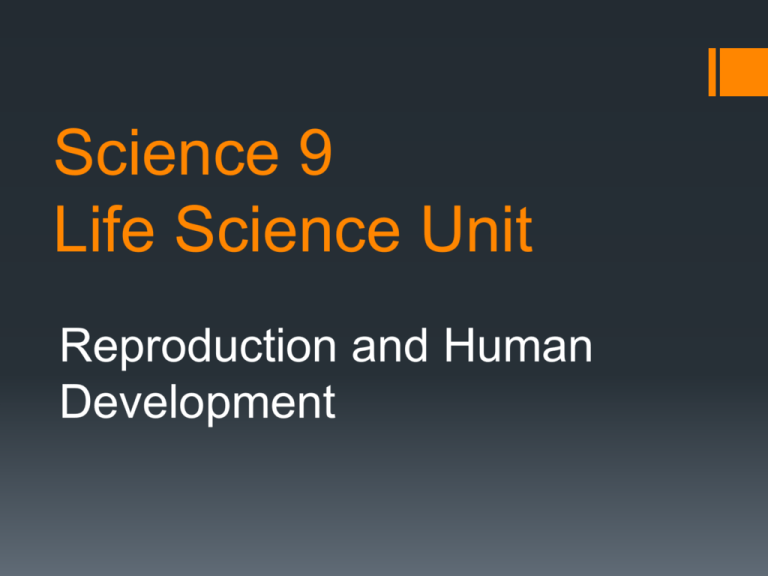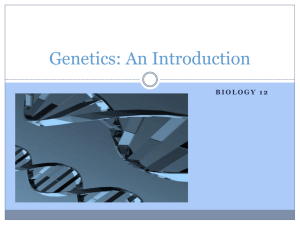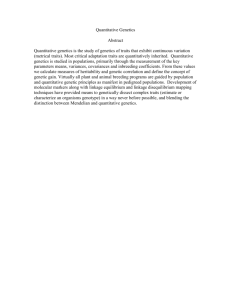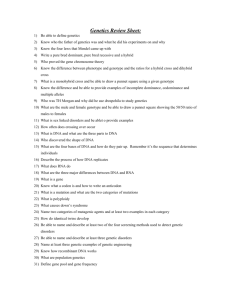Science 9 Life Science Unit
advertisement

Science 9 Life Science Unit Reproduction and Human Development Introduction to Cells and Genetics The wacky history of cell theory http://ed.ted.com/lessons/the-wacky-history-of-cell-theory Cell theory states: All organisms are composed of one or more cells. The cell is the basic unit of life. All cells come from pre-existing cells Cell theory was first proposed by German scientists Theodor Schwann and Matthias Schleiden. Introduction to Cells and Genetics Cells contain a complete copy of the genetic information that gives an individual organism the traits that make it what it is and not something else. Cells have life cycles. They are created, live, reproduce, and die. It is during the process of reproduction, or cell division, that genetic information is passed along. Introduction to Cells and Genetics There are two types of cells, prokaryotes and eukaryotes. Prokaryotes are simple cells which usually make up bacteria or single cell organisms. Eukaryotes are more complex cells which usually make up plants and animals. Introduction to Cells and Genetics Nucleus Genetic material is located in nucleus. It’s basically the brains of the operation, it tells cells how to reproduce and how something is made. Chromosomes Chromatin is located in the nucleus. Chromatin organizes itself into chromosomes during cell division. Chromosomes contain DNA. Each organism depending on its complexity varies in the amount of chromosomes it has. There are 46 chromosomes (23 pairs) in the human body. Whereas a frog has 13 pairs. Introduction to Cells and Genetics DNA The genetic information is stored in Deoxyribonucleic acid, DNA DNA contains the information needed to build an individual. Genes DNA is made up of genes. There are many individual genes withing the DNA and they contain the information that is needed to transfer specific traits from one oganism to another during reproduction. Introduction to Cells and Genetics Homework 1. What are some of the specific traits you inherited from your parents or features you have in common with your siblings? (make a list) 2. Research two genetic conditions that scientists are currently trying to learn more about its relation to genetics. How can we better understand its link to genetics in order to prevent or cure? 3. Who was Gregor Mendel? What did he contribute to the study of genetics? State the 7 traits he observed. Introduction to Cells and Genetics Read more: http://www.scienceclarified.com/scitech/Genetics/Genes-andDNA.html http://www.dnatutorial.com/DNAChromosomes.shtml http://anthro.palomar.edu/mendel/mendel_1.htm Heredity and Genetic Traits Supportive Links to videos and worksheets http://learn.genetics.utah.edu/content/inheritance/intro/ http://learn.genetics.utah.edu/content/inheritance/traits/ http://learn.genetics.utah.edu/content/inheritance/patterns/ http://learn.genetics.utah.edu/content/inheritance/activities/pd fs/Inherited%20Human%20Traits%20Quick%20Reference_P ublic.pdf Heredity and Genetic Traits Define: Allelle genotype Phenotype Recessive trait Dominant trait Homozygous heterozygous Additional Reading: http://www.merckmanuals.com/home/fundamentals/genetics/ genes_and_chromosomes.html?qt=&sc=&alt= Cellular Reproductive Processes In general, in order for cells to reproduce they make a copy of their genetic material and then they divide. A parent cell gives rise to daughter cells. We are going to study three basic ways in which cells reproduce. Binary Fission Mitosis Meiosis Cellular Reproductive Processes Binary Fission This process occurs in Prokaryote Cells (cells with no nucleus), like bacteria. The DNA is duplicated, and then the cell splits apart. The two cells will be exact replicas of one another, containing the same number of chromosomes. http://www.youtube.com/watch?v=3cD3U2pgb5w Cellular Reproductive Processes Mitosis In this process the cell will copy all of its’ DNA (remember two matching strands) to make two complete sets so that one set can be sent to each of the daughter cells. This is cell division in which the chromosome number remains the same, diploid to diploid. Mitosis is used for most of the cell division that occurs within your body and for most development and growth of living things. Cellular Reproductive Processes Cell Cycle Complete the cell cycle and mitosis note pages from the following web link http://www.biologyjunction.com/biology_color ing_worksheets.htm Cellular Reproductive Processes Meiosis In this process the cell will copy all of its’ DNA and make two complete sets, and then it will split into two cells so that there is one complete set of DNA in each of the two daughter cells. These two daughter cells will then split again, making four cells each with a single strand of DNA. This is cell division in which the chromosome number is halved, or from diploid to haploid. Meiosis is used to create the cells used for sexual reproduction.








